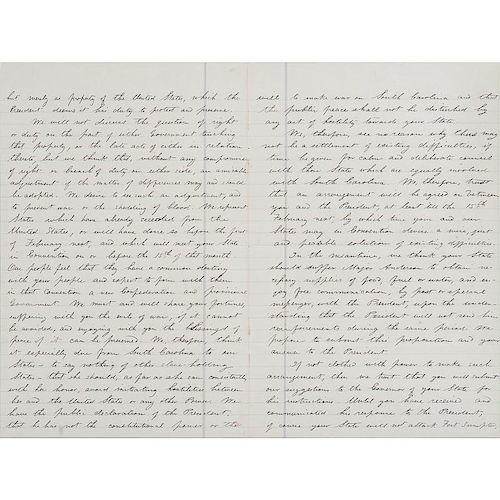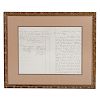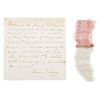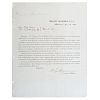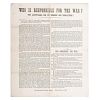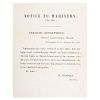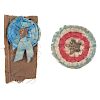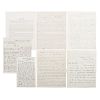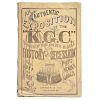The Year of Secession, 1861, Exceptional Confederate States of America Collection
About Seller
6270 Este Ave.
Cincinnati , OH 45232
United States
With offices in Cincinnati, Cleveland and Denver, Cowan’s holds over 40 auctions each year, with annual sales exceeding $16M. We reach buyers around the globe, and take pride in our reputation for integrity, customer service and great results. A full-service house, Cowan’s Auctions specializes in Am...Read more
Two ways to bid:
- Leave a max absentee bid and the platform will bid on your behalf up to your maximum bid during the live auction.
- Bid live during the auction and your bids will be submitted real-time to the auctioneer.
Bid Increments
| Price | Bid Increment |
|---|---|
| $0 | $25 |
| $500 | $50 |
| $1,000 | $100 |
| $2,000 | $250 |
| $5,000 | $500 |
| $10,000 | $1,000 |
| $20,000 | $2,500 |
| $50,000 | $5,000 |
| $100,000 | $10,000 |
About Auction
Nov 17, 2017 - Nov 18, 2017
Cowan's Auctions dawnie@cowans.com
- Lot Description
Superb collection of autographed letters, broadsides, patriotic covers, and additional Confederate ephemera dating from 1860-1861. Highlighted by a remarkable contemporary manuscript which heralds the intent of Confederate luminaries to establish “a new confederation” and urges South Carolina not to act precipitously against Ft. Sumter until that confederation is formed. The collection presents a fascinating glimpse into a country on the verge of war.
Taken together, the items included in this collection of Civil War memorabilia give witness to the highly combustible atmosphere that was the United States in 1860 and 1861. Offering both personal and distinct glimpses into the year our nation was torn apart, together with a variety of war-time ephemera from the “Year of Secession,” this collection is excellent for both research and exhibition at an institution or private collection.
The prelude to the Civil War was long and complicated, and the issues which plagued the young United States of America as it wrestled with sectional conflict are demonstrated in this collection as well. From concerns regarding slavery, state versus national allegiances, and the difficulties of establishing a new government, the documents reveal secessionist leaders boldly forging ahead with a Confederate government and preparing for war. In the midst of a rapidly evolving situation and the increased tensions which characterized 1860-1861, these documents further demonstrate Southern enthusiasm and hopes for a better future, while the few Northern letters in the collection demonstrate a sense of foreboding pessimism. In total, the collection contains an original copy of the Hayne/Ft. Sumter manuscript, 38 autographed letters, one small piece of the flag which flew over Ft. Sumter, three broadsides, one pamphlet, seven patriotic covers, and two Confederate secession cockades.
The centerpiece of the collection is the Hayne/Ft. Sumter manuscript. In this January 15, 1861, letter sent from “Washington City,” Jefferson Davis (1808-1889) and nine other southern politicians urge South Carolina to defer hostilities in the standoff with the U.S. government over Ft. Sumter. The authors call upon the recipient, South Carolina Attorney General Isaac W. Hayne, who was acting at the time as South Carolina’s envoy to President Buchanan, to wait to deliver his demand that Ft. Sumter be surrendered until after the first meeting of the Provisional Congress of the Confederate States. “We are apprized that you visit Washington as an Envoy from the state of South Carolina, bearing a communication from the Governor of your state to the President of the United States, in relation to Fort Sumpter [sic]. Without knowing its contents, we venture to request you to defer its delivery to the President for a few days or until you and he have considered the suggestions which we beg leave to submit.” After laying out arguments that possession of Fort Sumter by United States troops was not undertaken with “with any hostile or unfriendly purpose towards your state, but merely as property of the United States, which the President deems it his duty to protect and preserve,” the letter then turns towards its central purpose, “to prevent war or the shedding of blood. We represent states which have already seceded from the United States, or will have done so before the first of February next, and which will meet your state in Convention on or before the 15th of that month. Our people feel that they have a common destiny with your people and expect to form with them in that convention a new confederation and provisional government. We must and will share your fortunes, suffering with you the evils of war, if it cannot be avoided, and enjoying with you the blessings of peace if it can be preserved…. We, therefore, trust that an arrangement will be agreed on between you and the President, at least ‘till the 15th February next, by which time you and our States may in Convention devise a wise, just and peaceable solution of existing difficulties….”
Jefferson Davis originally signed the letter along with Louis T. Wigfall, John Hemphill, D. L. Yulee, Stephen R. Mallory, C. C. Clay Jr., Ben Fitzpatrick, A. Iverson, John Slidell, and Judah P. Benjamin. Davis thought it a significant enough letter to include it in its entirety in his own memoirs. The original was sold at auction in 1981; however, this is the only contemporary copy extant. Excellent condition. Entire letter written and signed by a clerk, 4pp, measures 16 x 11 in. and is matted to 21.25 x 17 in., then framed with glass on both front and verso allowing views of entire document.
There are 37 letters accompanying the Hayne/Ft. Sumter manuscript spanning December 11, 1860, through November 28, 1861, with one additional note dated August 1, 1865. These letters take the reader on a journey through a critical year in our nation’s history as the Southern states commit to their fight for independence. While the great majority of the letters are written to and from secessionists, a few letters in the collection do represent the Northern perspective on ongoing political events. Nowhere is Northern alarm at the rising sectional tensions clearer than in the earliest letter of the collection. Writing to New York lawyer Lloyd Aspinwall from Washington, D. C., the author J. (?) P. (?) Stone offers his opinion on all that he has seen and heard in the capital city. He believes that “only by desperate remedies can the country be held together.” Stone then continued, “Madness is the order of the day among extreme Northern men, anxiety and fearfulness among the border men…. The extremists of South Carolina, Georgia & Miss. are bold & defiant & insulting. They go for secession, no matter what compromises may be proposed by the North…. I do not believe, from all I can see & hear, that, unless prompt action is taken, the country will hold together four months longer.” Little more than a week after this prophetic letter was written, South Carolina seceded from the Union.
With the secession of South Carolina, Southern politicians and military leaders began to lay their plans for a future Southern Confederacy. Georgia Governor Joseph E. Brown, a leading secessionist, figures prominently in the collection as numerous letters are written to/from him in this critical period after South Carolina secedes and before the outbreak of the Civil War. A fascinating letter dated January 14, 1861, from North Carolina Governor John Willis Ellis (1820-1861) to Governor Brown outlines the status of U. S. forts in North Carolina and the issues which impact North Carolina’s decision whether or not to secede. A January 21, 1861, letter also from Ellis to Brown reflects the important role slavery had not just in negotiations between North and South, but also between the Southern states themselves: “I have the honor to acknowledge the receipt of two dispatches from you on the 19th inst. The latter of which informed me that Georgia had formally seceded from the Union. / I trust that this event is the beginning of a future of prosperity, peace and happiness for the people of Georgia, and my earnest desire is, that North Carolina will soon unite her destinies, by formal act, as they are now in fact united with the Seceding States.” Ellis then cautions Brown that any new constitution adopted at the Convention of states which had seceded must include a clause “to prohibit the importation of slaves from other States and Countries” so as to help ensure that Virginia, North Carolina, Maryland, and Kentucky will enter into the new Confederacy. Ellis continues, “I doubt not, in a moral point of view, that the importation of savages from Africa and making slaves of them would be the best thing we could do for them. But I view the question in political bearings….”
In a letter written on that same day, West Point graduate and Lieutenant Colonel of the 1st U. S. Cavalry William Joseph Hardee (1815-1873) writes the Georgia Governor that he recently learned that his home state of Georgia had passed the ordnance of secession. Like all Southern military men of his time, Hardee had to pick a side. “My allegiance is due to my native state,” he assured the Governor, “and I am ready to resign my commission in the U. S. Army whenever you may need my services….” This decision carried risks, and Hardee issued a warning to the Governor to end his letter, “Until I resign this correspondence & my views had better not be made public.”
As Southern military and political leaders began to stake their fortunes with one side or another, the most prominent secessionist leaders gathered in Montgomery, Alabama, to draft a new Constitution and establish a government. In a letter dated March 4, 1861, the newly appointed Secretary of State for the Confederacy, Robert Augustus Toombs (1810-1885) writes to Governor Brown discussing military appointments and the work at the Convention. “We are getting on slowly at this time, but the work is tedious. We are now on the permanent Constitution & hope to get through with it at least in time to get it to Savannah by Monday next. We are sitting day and night in order to get through. I feel a little uneasy about one or two clauses which it is proposed to put in but I hope finally good sense will prevail over temporary passions & ideas.”
When the Confederates finally fired upon Ft. Sumter on April 12, 1861, the Southern states had already been preparing for armed conflict. They worked quickly to raise their armies and fortify their defenses. Mere weeks after becoming the first state to secede from the Union, South Carolinians were already making military preparations and securing additional arms. Christopher G. Memminger (1803-1888), CSA Secretary of Treasury, writes to Col. Edward Manigault from the Executive Office in Charleston on January 8, 1861, about appropriations for arms and general military purposes. A letter dated February 25, 1861, from Confederate S. R. Gist, then serving as adjutant general of the South Carolina Militia, documents efforts to create the Confederate army when as of yet only half of its states had seceded. Gist directs a colonel to allow the exchange of muskets now in the possession of the Corps “for the new U. S. muskets, Springfield. The Corps are ordered for special duty in camp tomorrow morning.” A letter of May 15, 1861, from Confederate General Daniel Ruggles (1810-1897) to Col. R.S. Garnett discusses preparations for the defense of Fredericksburg – anticipating the strategic importance of this site more than a year before the devastating battle which would occur there. Ruggles relates procedures for handling the approach of vessels approaching via water, as well as measures he deems necessary for the protection of the city such as controlling small boats using inlets, censoring mail, and requiring that passports from civilians should receive the countersign of military commanders. Even with experienced military leaders like Ruggles in its service, it is clear at this very early date in the fight for independence that the South will struggle with securing the supplies it needs to wage war. Confederate General and former U. S. Secretary of War John Buchanan Floyd (1806-1863) writes on June 10, 1861, to Gov. Joseph E. Brown, a significant letter in which he asks the Governor “an unusual favor.” He pleads directly with the Governor to provide his brigade of riflemen in camp in Virginia with rifles, because “They are without arms, and the Confederate States – to which service they belong – are without arms to furnish them.”
Governor Brown was a staunch supporter of the Confederate cause. However, his own words in this collection presage the ongoing argument that would pit him against President Jefferson Davis and the Confederate government’s wartime policies. Brown did not support the draft and wanted the local militia to remain in his state for the defense of Georgia. On July 8, 1861, Brown writes Leroy Pope Walker, Secretary of War for the C.S.A., inquiring about Pope’s request for additional regiments of infantry armed and equipped. “I do not understand you that these two regiments are required as a part of Georgia’s just quota, as I am satisfied you will admit she has done as much as her just proportion when she shall have furnished the three thousand men added to those already sent forward. I am not disposed however to discuss the question of quota. If the troops are needed and the wishes of the Government of Georgia in matters vital to her interest and honor are respected I shall do all in my power to gratify every wish of the President.” Brown further pursued his questions about furnishing additional regiments directly with CSA Secretary of State Robert Toombs and with President Davis as well, and those letters are included in this collection.
As the “Year of Secession” draws to a close, the outcome of the war remains uncertain and those who would shoulder the immense burden of the Confederate cause – the Southern soldiers – were keenly aware of the politics that figured prominently behind their exertions on the battlefield. On October 10, 1861, Archie H. Cole, Lt. Col, CSA and Inspector General of Field Transportation writes to Brig. Gen. Roswell S. Ripley lamenting the “stifling of true merit and such glaring attempts to bolster up old Government fossils, and military fogyism.” He then continues, “I sometimes begin to think that our new concern is fast drifting into all the political rascality that formerly infected Washington City. I am quite sure of one thing, that certain favorites are already marked out who are in spite of h ---l to enjoy and wear the laurels of all of our victories”
Many other prominent soldiers and politicians from both sides are represented in this collection. Additional letters include the following: ALS to U. S. Secretary of War Simon Cameron dated March 27, 1861, and signed by United States Army officers including Joseph E. Johnston (later of the CSA), Edward D. Townsend, Erasmus D. Keyes, Winfield Scott, and Lorenzo Thomas; ALS from the “Hero of Fort Sumter” Robert Anderson to General John Adams Dix, of the New York Militia, written on May 31, 1861, while serving as commander of the Department of Kentucky; ALS from Confederate Major General Gustavus W. Smith to President Jefferson Davis dated November 28, 1861; and letters signed by Albion Paris Howe, Philip H. Kearny, Fitz John Porter, Stephen Russell Mallory, and Ambrose E. Burnside. Letters written by both Northern and Southern foot soldiers enhance the collection with the common experience of the everyday men whose lives were forever changed by war.
One autograph in the collection includes a unique piece of Civil War memorabilia. A note signed by Benson J. Lossing, testifies that “This piece of the flag was presented to me this day, August 1, 1865, in my Library in Poughkeepsie by Major General S. W. Crawford, who was a Surgeon in Sumter during the siege. He took from the flag, where it was tattered by rebel shot, a small piece from which this was cut.” The Ft. Sumter flag remnant referenced is included with the note. It is half red and half “white,” 4.5 x 1.25 (irregular) inches.
Rounding out the collection are three broadsides, a pamphlet, seven patriotic covers, and two Confederate secession cockades.
Printed broadside, 7.75 x 10 in. NOTICE TO MARINERS. (No. 106) Treasury Department, Office Light-House Board, Washington D.C.: January 26, 1861. “Information has been received at this office that the light-vessel at Rattlesnake Shoals has been withdrawn; that the lights on Morris Island, and at the entrance into the port of Charleston, S. C., have been discontinued; the buoys removed and the main ship channel so obstructed as to be unsafe for navigation.” Signed in type by “R. SEMMES, Secretary.” Raphael Semmes (1809-1877) was an officer in both the United States and Confederate Navies. Semmes issued this notice just twenty days before resigning from the U. S. Navy to join the secessionist cause. The actions reported here represent one of the very first military actions of the Civil War and were an important part in the escalating conflict following South Carolina’s secession. Excellent condition with light folds and light toning.
Printed broadside, 7.75 x 9.75 in. An Act to Amend An Act Entitled “An Act recognizing the existence of war between the United States and the Confederate States, and concerning Letters of Marque, Prizes, and Prize Goods, approved May 6th, one thousand eight hundred and sixty-one.” [Montgomery]: [Congress of the Confederate States of America], May 21, 1861. This amendment to an act of May 6, 1861, increases the reward payments for the sinking of Union ships by privateers and requires that inventions of “any new kind of armed vessel, or floating battery, or defence” shall be filed with the Confederate Navy while still guaranteeing rights to inventors. One sheet with integral blank leaf. Unbound as issued. First printing; good condition though folded at horizontal center. “Record Division War Department, Rebel Archives” stamped on verso in red.
Printed broadside, approximately 9.5 x 11.25 in. WHO IS RESPONSIBLE FOR THE WAR? WHO ACCOUNTABLE FOR ITS HORRORS AND DESOLATIONS? … WHO COMMENCED THE WAR? EXTRACTS from a Speech by Alexander H. Stephens (now Vice-President of the Confederate States), delivered in the Secession Convention of Georgia, on the 31st day of January, 1861:” Unknown location: [National Union Party, c. summer 1864]. Small folio; 1 p in two columns. Some wear and minor separation along vertical and horizontal folds, with scotch tape used to repair a tear on upper left. Light toning and very minor foxing. Verso covered in penciled sums, however, writing does not bleed through to front of broadside.
Pamphlet, approximately 4.75 x 7 in. AN AUTHENTIC EXPOSITION OF THE “K. G. C.” KNIGHTS OF THE GOLDEN CIRCLE OR A HISTORY OF SECESSION FROM 1834 TO 1861. By a MEMBER OF THE ORDER. Indianapolis: Asher & Co., 1861. The Knights of the Golden Circle was a secret society which gained notoriety with the onset of the Civil War. Its initial aim was to expand slaveholding interests into a “golden circle” of the Southern Hemisphere, however, with Lincoln’s election the society turned its efforts to support the southern cause. The society is believed by some to have played a controversial part in the war specifically with regards to Lincoln’s assassination, and served as a pre-cursor for later organizations such as the KKK. A unique piece of memorabilia with background on the order as well as information on its rituals and organization. Printed yellow wrappers; 88 pp; three full-page woodcut illustrations. Front cover slightly soiled with minor folds, but overall in good condition.
The patriotic covers, all circa 1861 and of Union origin, are titled as follows:
1 – SECESSION WAGON – Jeff Davis—My wagon is kind of caving in. I am afraid Uncle Abe will catch me before I get far with these goods.
2 - THE IMPENDING CRISIS [note: 7 stars only]
3 - SOUTHERN MENAGERIE IS COMING
4 – END OF SECESSION
5 – SCOTT’S EXTINGUISHER
6 – THE UNION MUST & SHALL BE PRESERVED.
7 – SECESSION WEB. Walk into my parlor, says the Spider to the fly.
The two Confederate secession cockades which are part of this collection are enclosed in a case. They are each in excellent condition. Worn by men, women and children in the South, Confederate cockades were typically pinned to the lapel. A variety of color variations existed, but most cockades were blue and often included a center emblem. They have become quite scare on the market.
The first cockade in the collection is from the state of Texas and is in the typical style of a blue rosette with ribbons and center embellishment. It appears to be mounted on a brown cloth material. A newspaper clipping accompanying the cockade reprints portions of two 1860 articles describing Texans proudly adorning themselves with cockades. From the Dallas Herald, December 5, 1860, “Many of our citizens appear on the streets of Dallas wearing the cockade of our national colors, blue ribbon with a golden star…,” and then from The Indianola Courier of November 24, 1860, “We have observed, for a few days past, a number of blue cockades, surmounted by metallic five-pointed stars, worn on the hats and coats, of many of our citizens. The cockade is the badge common to the citizens of the Southern States. The star is peculiar to Texians.” The second cockade, a rosette of red, white, and blue, and adorned in the center with a golden star, is attributed to the state of North Carolina.
All items are in excellent condition unless otherwise noted. Full content listing available upon request.
Condition
Eliminate the Hassle of Third-Party Shippers: Let Cowan's Ship Directly To You!
If you'd like a shipping estimate before the auction, contact Cowan's in-house shipping department at shipping@cowans.com or 513.871.1670 x219. - Shipping Info
-
Eliminate the Hassle of Third-Party Shippers: Let Cowan's Ship Directly To You!
If you'd like a shipping estimate before the auction, contact Cowan's in-house shipping department at shipping@cowans.com or 513.871.1670 x219.
At the request of the buyer, Cowan's will authorize the shipment of purchased items. Shipments usually occur within two weeks after payment has been received. Shipment is generally made via UPS Ground service. Unless buyer gives special instructions, the shipping method shall be at the sole discretion of Cowan's Auctions, Inc.. Cowan's is in no way responsible for the acts or omissions of independent handlers, packers or shippers of purchased items or for any loss, damage or delay from the packing or shipping of any property.
-
- Buyer's Premium



 EUR
EUR CAD
CAD AUD
AUD GBP
GBP MXN
MXN HKD
HKD CNY
CNY MYR
MYR SEK
SEK SGD
SGD CHF
CHF THB
THB